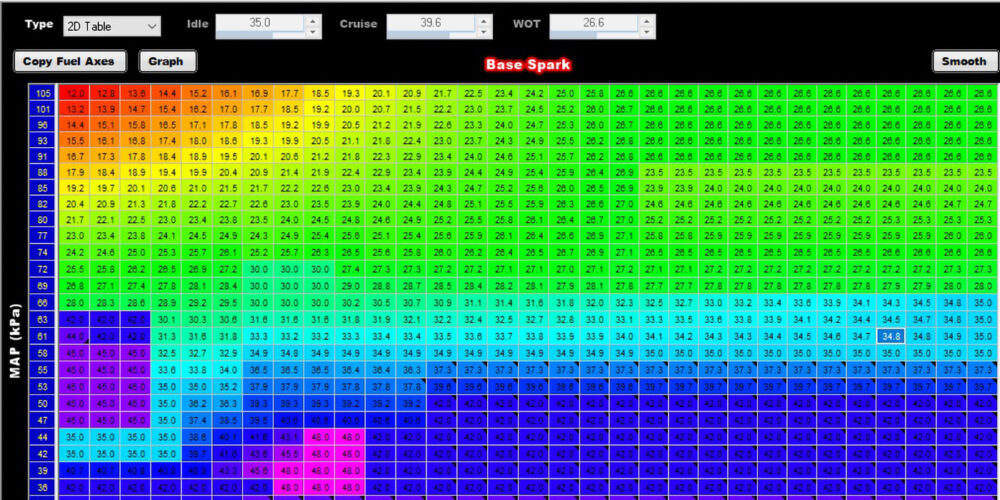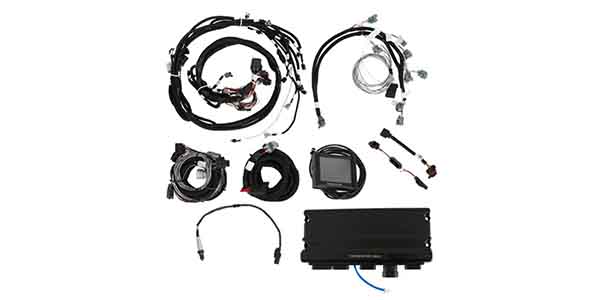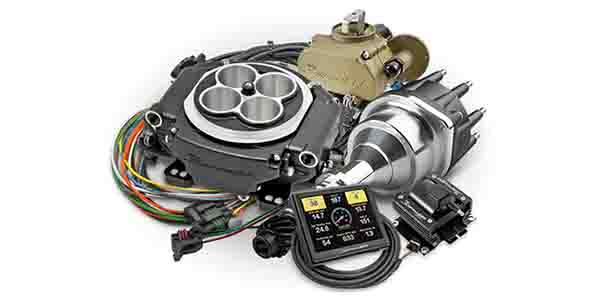How many of you can remember locking out the timing and removing the vacuum advance from your streetcar distributor? It used to be what all the racers did. I was as guilty as the rest, but it was because I did not fully understand the dynamic of timing advance and engine performance. Controlling ignition timing with your EFI ECU has many advantages today.
For most folks, the correct timing curve can be more mysterious than the correct air/fuel ratio. How does one find the correct timing curve and more importantly, implement it? Back in the day, an OEM would use a mixture of mechanical and vacuum advance to add and subtract timing based on engine speed and load. What made this process difficult was the inability to change timing values in real time and the lack of control at the vacuum advance. The easy fix was to just lock the timing or just remove the vacuum advance and add some lighter advance springs. What we lost was the ability to add timing at light cruising loads to help keep the engine efficient and cool. Today, an OEM uses timing control and coil-near-plug (CNP) technology to help meet engine performance and emissions demands.
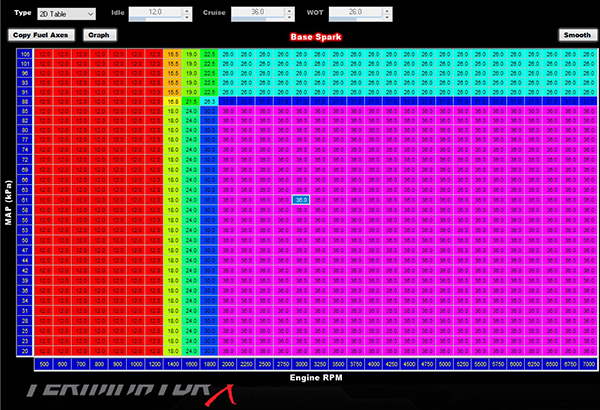
OEM Ignition Tuning Strategies
OEM engines, whether stock or high performance, have slightly different goals than your typical high-performance street or race engine. The primary objective for an OEM is to meet an NOx emissions target centered around idle and cruise. The ideal way to control NOx emissions is with retarded timing, and it is not uncommon to observe idle timing below 10 degrees before top dead center (BTDC) and timing after top dead center (ATDC) once timing trim is added in.
CNP ignitions allow these large swings in timing without upsetting the critical rotor phasing relationship of a typical distributor-based ignition. A late-model OEM engine is engineered to work in the hostile, late-ignition timing environment with optimized static compression along with a cam designed to meet the required dynamic compression. Without the use of computer-controlled timing, the OEMs would not be able to meet both the emissions requirements of the state and the drivability and performance demanded by the consumer.
High-Performance Ignition Tuning Strategies
Let’s take this same refined OEM engine and modify the inner workings, creating a more performance-oriented engine. In this instance, we will replace the stock cam with an aftermarket cam that sports an increase in duration @.050 lift, more overlap and possibly a narrower lobe center. Along with our cam change, many now feel it’s important to move into a higher octane fuel. These upgrades may not significantly change wide open throttle timing, but this cam and fuel change will drastically alter the cylinder pressure at idle and part throttle cruise.
This reduction in cylinder pressure, along with the slower burning fuel, reduces dynamic cylinder pressure, resulting in incomplete combustion in the chamber, lazy throttle response, loss of power, and the continuation of the combustion process in the exhaust, especially at OEM timing values.
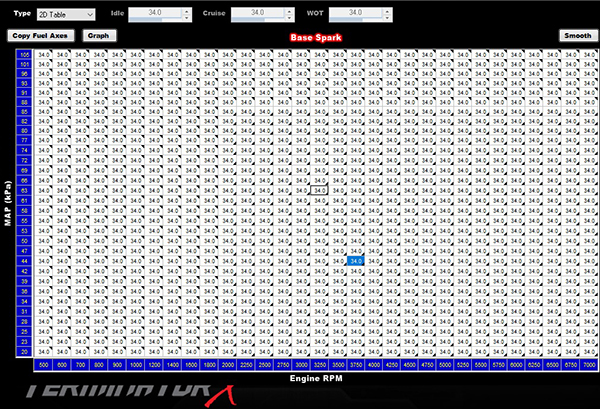
Late ignition events can also manifest themselves in exhaust headers that glow along with dirty chambers that won’t accept fuel when the throttle is moved aggressively, causing a stumble. Adding timing at these points will dramatically increase efficiency, throttle response and exhaust temperatures. If we apply the same symptoms of late ignition timing to our theoretical hot rod engine at cruise rpm, we may not really know there is an issue until the coolant temperature starts to creep into the danger zone.
This is a direct result of incomplete combustion of the working fluid within a prescribed crankshaft travel of typically 20 degrees ATDC. When combustion is still occurring after this time frame, we start to use the cylinder bore as a heat sync, which can easily overpower the cooling system. Adding timing to the cruise area helps reduce internal engine temperature keeping the cooling system in check. With EFI timing control we can easily optimize the timing for the combination, increasing efficiency, power, throttle response, along with a reduction in coolant temperature. This is just not possible with locked timing and can be quite difficult to optimize with a vacuum advance.
This same ideology applies to any engine build as every engine is unique and has its very own distinct timing requirements. Optimizing the fuel and timing takes patience along with experimentation to find the ideal values. Without computer-controlled timing, it would be next to impossible to optimize the tune. Although not employed in the aftermarket as widely as it could be, knock control can give us an idea of over-advanced timing and can really help maximize part throttle and light-load tuning. Relying on knock can be difficult with certain high-performance applications, including those with loose piston-to-wall clearance, mechanical lifters, gear drives, blowers, etc.
Years ago, when I designed my 13:1 compression, 582 cid big block Chevy for drag-and-drive competition, I used a rather large camshaft (284/[email protected] on a 112 lobe center) to bleed off cylinder pressure to run 93 octane pump gas on the road. I started the timing curve at 18 degrees at idle and 22 degrees at cruise due to frightful input from a fuel supplier. He was wrong and I promptly melted all the wiring within a foot of the glowing headers. Lesson learned!
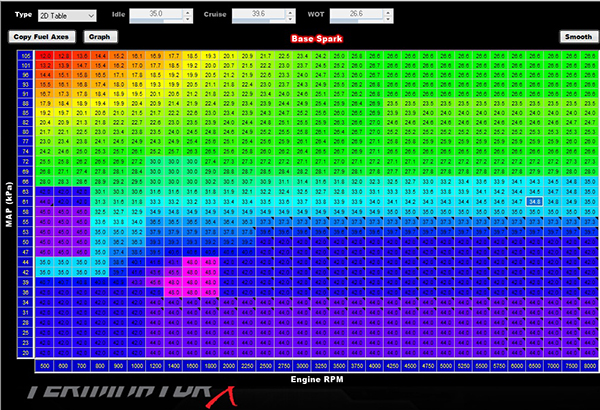
I currently idle at 30 degrees and cruise close to 40 and the coolant never makes it past 190 degrees – even on the hottest days. This is not to say that it wasn’t possible to optimize timing with this combination without EFI, but more to showcase that the entire engine dynamic is critical when optimizing timing and that it is far easier to find that critical balance with computer-controlled timing.
Racing Ignition Tuning Strategies
Lock her out and send it! Not so fast. This is a great way to leave performance on the table. Sure, we can retard timing in high gear just as they have done for years, but one can now optimize timing per gear as the engine load changes with every shift. How about when we gear recover into the top of the torque curve when cylinder pressures are the highest? Timing on the two step? Timing versus nitrous pressure and load? Versus length of time in land speed? Versus boost and inlet air temps? How about using timing as a safety when we see out of range changes in air/fuel ratio and fuel pressure? Move into CNP plug control for individual cylinder timing and to eliminate rotor phasing issues? The list is next to endless! These features can also be employed in streetcars. All it takes is the desire to use timing control to its fullest to optimize your combination.
Crank Reference Angle
Crank reference angle or the degree before TDC of the crank input expected by the ECU, is an integral part of the internal calculations used by the ECU to supply the commanded timing event and can be confusing terminology for some. First, let’s veer off course for a moment to consider the fact that an ECU is based on nothing more than math calculations. It calculates rpm from the time interval of the crank input and knows that the timing cycle is 720 degrees (two complete revolutions of the four-cycle engine) before it repeats.
Simple enough, but how does crank reference angle come into play? The ECU is fast enough to look at certain user-defined and required internal calculations based on the time interval between each crank input. Each crank input is dynamic and lands the ECU onto a certain part of the fuel and spark maps. But the ECU needs a certain amount of time to “digest” that input, so we need to build in time for it to calculate the output.
Crank reference angle is typically 10 degrees more than the peak timing value allowed for that crank input. Therefore, with a 50-degree reference angle, we are allowed a peak timing value of 40 degrees for that crank input. For a 70-degree reference angle, we can command up to 60 degrees of timing for that crank input. It would be impossible to command a 30-degree timing value with a 30-degree reference angle for that crank input as there is no time for ECU calculations. The misconception occurs when the laymen confuses crank reference with ignition timing and assumes a potential over-advanced concern.
That is not to say that with a 30-degree reference angle, one could not command 40 degrees of timing. The ECU would just default to the next crank input to land the timing on that desired event. For most applications, the delay in timing to the next crank event will never make a difference, but for serious race applications, we keep the timing tied to the respected crank input by using the correct crank reference angle.
In closing, I don’t think anyone can overstate the fact EFI timing control has radically changed the ability for anyone to fully, and correctly, optimize an ignition timing curve, assuming they are interested in investing the time. Thank you for tuning in, and I’ll see you at the races! EB

